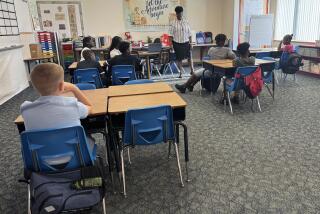W. Covina May Not Close a 5th School
- Share via
WEST COVINA — The school board, which has voted to close four schools next year and was advised to close a fifth, strongly indicated Tuesday that it may not close another school.
In line with a proposal from district administrators and a special study committee, the board was considering closing either California, Wescove or Orangewood elementary school as a further cost-cutting measure.
But Supt. Jane D. Gawronski made a new recommendation Tuesday night--not to close an additional elementary school. Gawronski said the district’s inability to decide which school to close, savings that may come through other means and a possible enrollment increase made closing another school too risky at this date.
By delaying the decision until May, when more of these variables will be known, Gawronski said, the district could find that it doesn’t need to close another school.
“We don’t want to close another school and then in a few years be reopening it,” she said. “We want to address the long haul and not the immediate financial problem.”
In February, the board voted to close Edgewood High School, Hollencrest and Willowood intermediate schools and Cortez Elementary School. The board also decided against closing Merced Elementary School, as recommended by the special committee, and deferred a decision on closing another elementary school.
The closure decisions came after a deficit in the 1986-87 school year forced the district to borrow $3.3 million from the state, $1.5 million of which must be repaid next year. Gawronski estimated that the district must cut $2.7 million to stay out of the red next year.
“We already closed a school on the east side,” Gawronski said. “If we close another one on the east side, all those schools will be up to capacity.”
Running seven elementary schools at or above full capacity could wipe out any savings from closing another elementary school, she added.
“If we can develop a balanced budget for next year, the board is saying we are willing to operate with (the current) eight schools,” she said.
Waiting to See
Board members said they are receptive to Gawronski’s latest recommendation because they could not target an additional school for closure and were waiting to see if other cuts could save the school. They were unable to vote on her recommendation Tuesday night because it was not on the formal agenda.
“What we’ve essentially done was delay this process until we can look at every other alternative,” board member William J. Brutocao said. “Only as a last resort will we consider closing another school.”
Brutocao said the district will pursue a number of other cost-cutting measures, including renegotiating a loan repayment schedule with the state, maximizing the savings from the approved closures and pursuing more reductions in operating expenses.
“I am optimistic that we can get through the (budget) crunch without having to close another elementary school next year,” he said. “When you are confronted with these kinds of changes--the only reason to make them is to save money--you’re going to look for every alternative available.”
Although the enrollment figures indicate that another school could be closed, some board members said the layout of the district makes such a decision difficult.
“I sense that there is a consensus that there is enough information available to close another elementary school,” said board member Elias Martinez. “However, there is no single school . . . that stands out as being the optimum one to close.”
Board member Karen Welts agreed, saying the district should not hurry into a bad decision.
“We’re not moving ahead at this point,” Welts said. “I think we need to take a step back, because one of the worst things we can do is close a school and find we want to do things differently a year later.”
Financial Effect
Welts and Martinez said delaying a decision will allow the district time to implement the other changes and examine the financial effect.
“I hope to wait another year and see if we can get by without another closure,” Welts said. “I’m rather relieved that we put this on hold.”
Gawronski said saving another elementary school will depend on how many other cuts can be made.
“It’s going to depend on the board’s and staff’s ability to come up with reductions,” she said.
Reducing the number of school nurses, counselors and noontime playground supervisors and eliminating elementary music programs could make part of the difference, she said.
Because of the consolidations, administrators estimate that between 25 and 50 teachers could be laid off next year.
Delaying the decision will also give administrators time to evaluate the savings already achieved by closing four schools, she said. Earlier estimates put the savings between $1.4 million and $1.7 million.
“This gives us the time to cost that out for savings next year,” she said.
Under the consolidation plan, West Covina High School will become the only high school. Edgewood High School will become a middle school.
Principals Retired
The board appointed new principals because of the school closures.
Because three elementary principals retired, no reductions are needed at the elementary level, administrators have said.
Doug Koel, principal of West Covina High, will stay on next year when the school absorbs Edgewood’s students. Hollencrest Principal Kenji Kinoshita will run the middle school.
The action displaces current Edgewood Principal Don Banderas and Willowood Principal Maria Caterinicchio. Their options include applying for the open assistant principal’s job at the high school or taking another post within the district, officials said.
The board also appointed John Hoover and Gloria McGehee, both assistant principals at Hollencrest and Willowood schools, to be Kinoshita’s assistant principals at the new middle school.
More to Read
Sign up for Essential California
The most important California stories and recommendations in your inbox every morning.
You may occasionally receive promotional content from the Los Angeles Times.










